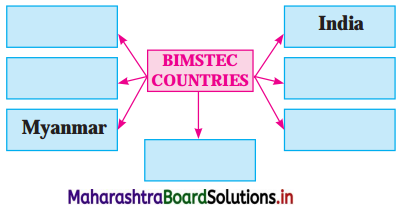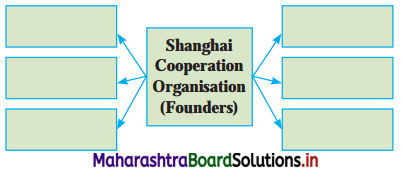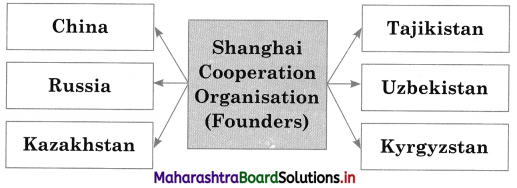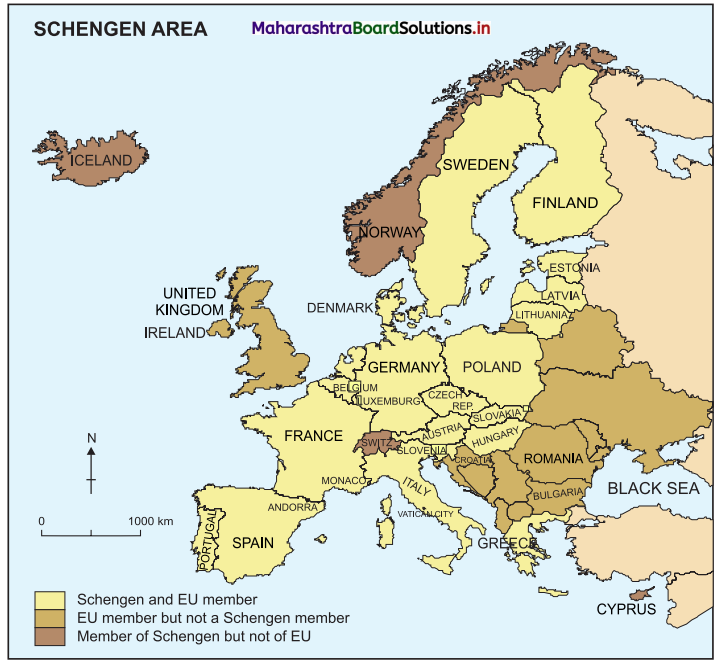Balbharti Maharashtra State Board Class 12 Political Science Solutions Chapter 1 The World Since 1991 Textbook Exercise Questions and Answers.
Maharashtra State Board Class 12 Political Science Solutions Chapter 1 The World Since 1991
1. (A) Complete the following statements by selecting the appropriate option.
Question 1.
One of the important trends in the post-1989 international relations was
(a) End of bipolarity
(b) Rise of regionalism in Asia
(c) End of non-alignment
(d) Demand for a new international economic order
Answer:
(a) End of bipolarity
![]()
Question 2.
The ‘Maastricht’ Treaty is with reference to
(a) United Nations Peace Keeping Force
(b) European Union
(c) American interventions in Kuwait
(d) Creation of BRICS
Answer:
(b) European Union
1. (B) State the appropriate concept for the given statements.
Question 1.
When a State influences other States without the use of military force.
Answer:
Soft power
Question 2.
A State with a leading position in international politics with abilities to influence global politics and fulfill its own interest.
Answer:
Super power
2. (A) Complete the concept maps.
Question 1.

Answer:

Question 2.

Answer:

2. (B) Observe the maps in the textbook and answer the following questions.

Question 1.
Name any four countries in the Schengen area.
Answer:
Sweden, Denmark, Germany, Belgium, France.
![]()
Question 2.
Name any two non-European Union countries within Schengen area.
Answer:
Norway, Romania, Bulgaria, Croatia.
3. State whether the following statements are true or false with reason.
Question 1.
SAARC is important for trade in South Asia.
Answer:
This statement is True.
(i) SAARC has eight member States from South Asia. It aims to accelerate economic growth and promote the welfare of the people of South Asia.
(ii) In 1993, South Asian Association for Preferential Trade Agreement (SAPTA) came into existence. It was replaced in 2006 by South Asian Association Free Trade Area (SAFTA). This helps in trade and economic activity in the region.
Question 2.
‘Maastricht’ Treaty was signed for the defence of Europe.
Answer:
This statement is False.
(i) On 7th February 1992, the Maastricht Treaty was signed to create the European Union.
(ii) This treaty led to the expansion of spheres of cooperation in internal affairs, foreign policies and defence policies.
Question 3.
The decade of 1980s is seen as the golden age of humanitarian intervention.
Answer:
This statement is False.
(i) The 1990s are seen as the ‘golden age of humanitarian intervention.’ In 1993, the World Conference on Human Rights was held in Vienna, which led to the creation of the office of UN High Commissioner for Human Rights.
(ii) Increasing awareness about human rights and their protection in international law gave rise to the phenomenon for protection of rights in the form of ‘humanitarian intervention’.
![]()
4. Express your opinion of the following.
Question 1.
Humanitarian intervention
Answer:
One of the main purposes of the UN is maintenance of international peace, security and cooperation. UN Peacekeeping Force comprises of military personnel and resources sent by member States. In the post-cold war era, the UN rationale for intervention was not just to stop ongoing wars but also to prevent reoccurrence of conflicts and protect the human rights of the affected people. The UN intervened in Cambodia, Somalia, Yugoslavia, East Timor, Eritrea, Syria, etc., for this purpose.
In 1993, over 170 nations participated in the World Conference on Human Rights, held in Vienna to reaffirm their commitment to protect human rights. The office of the UN High Commissioner for Human Rights was created to coordinate human rights initiatives. The increasing awareness about human rights protection in international law gave rise to humanitarian intervention especially in conflict zones. NGO’s have contributed significantly in the spread of humanitarian intervention for e.g. ICRC, Oxfam, etc. The 1990s are described as “golden age” of humanitarian intervention.
![]()
Question 2.
Regionalism in international politics.
Answer:
Countries which lie in geographical proximity create or join regional organisations which are based on common political, ideological, economic and infrastructural concerns. Some nations make special agreements regarding trade and economic cooperation. This is called a trade bloc.
(i) European Union (EU) was created in 1992 by Maastricht Treaty. It led to increased spheres of cooperation between European nations e.g. foreign affairs, defense, trade and creation of Euro as a common currency. Creation of Schengen Area is one of the achievements of the EU since the Schengen visa allows eligible individuals to travel freely within the 26 nations of the Schengen area.
(ii) ASEAN created in 1967 with headquarters at Jakarta comprises of 10 South-East Asian nations such as Brunei, Indonesia, Malaysia, Singapore, etc. It aims to promote political economic and security cooperation among it’s members.
(iii) SAARC formed in 1985 at Dhaka with 7 members. Today, it has 8 member countries of South Asia like India, Bhutan, Pakistan, etc. It aims to promote regional integration and economic development. It’s main achievement is the SAFTA.
(iv) BIMSTEC – is a regional organisation founded in 1997 comprising of 7 member countries lying around Bay of Bengal for e.g. Bangladesh, India, Thailand, Myanmar. It aims to facilitate collaboration in economic, security and other concerns between member States.
(v) Shanghai Cooperation Organisation (SCO) is an Eurasian political, economic and security organisation formed in 2001 with 6 member states. In 2016, India and Pakistan joined SCO. It’s focus is on maintaining peace and stability in the region, cooperation in trade, technology, etc.
Regional organisations play an important role in international politics. Due to this, unipolarity (US as the only superpower) ended leading to multipolarity.
5. Answer the Following.
Question 1.
Explain the term soft power with examples.
Answer:
According to American academic, Joseph Nye there are two types of power viz. hard power and soft power.
(i) Hard power is the ability to get others to act in ways that are contrary to their preferences and wills. It is the ability to coerce through threats and inducements for e.g.,Iraq invasion of Kuwait.
(ii) Soft power is when a country influences other countries without the use of military force. It is the ability to get others to want the outcomes that you want i.e. through attraction rather than coercion. Such influence is spread through economic, socio-cultural means.
Soft power was an important aspect of US domination. It implied the use of monetary aid, cooperative programmes, cultural exchanges, strong relations with allies. Examples of US soft power are cultural exports like fast food chains, movies, educational exchange programmes as well as disaster assistance programmes such as tsunami relief (Japan), flood control (Pakistan).
![]()
6. Answer the following question in detail with help of given points.
Question 1.
Discuss the European Union with help of given points.
(a) History
(b) European Commission
(c) European Parliament
(d) European Council
(e) European Court of Justice
Answer:
(a) History – The European Coal and Steel Community (ECSC) and European Economic Community (EEC) were created to foster economic interdependence. On 7th February 1992, the Maastricht Treaty was signed to create the European Union. This led to expansion of spheres of cooperation to include internal affairs, judicial matters, foreign policy, etc. The Euro (€) is the official currency of 19 out of 28 countries of the EU. These nations are collectively called ‘Eurozone’.
(b) European Commission – The Commission is the executive bureaucratic arm of the EU. It is mainly responsible for drawing up proposals for new European legislation,and it implements the policy decisions of the European Parliament and the Council of the EU.
(c) European Parliament – The European Parliament is composed of 751 Members, who are directly elected every five years. It is a body entrusted with legislative, supervisory, and budgetary responsibilities.
(d) European Council – The structure of the European Council consists of the Presidents or Prime Ministers of each member State, accompanied by their foreign ministers, and a full¬time President of the European Council. The European Council meets four times a year and provides strategic leadership for the EU.
(e) European Court of Justice (ECJ) – The ECJ interprets, and adjudicates on, EU law and treaties. As EU law has primacy over the national law of EU member States.
![]()
ACTIVITY
Find out the role played by India in BRICS (Text Book Page No. 13)
Answer:
BRICS refers to five major emerging national economies, i.e., Brazil, Russia, India, China and South Africa. It accounts for about 40% of the world’s population and 20% of the GDP. It is an emerging investment market and global power bloc. India serves a multi faceted role on the economic and political fronts.
(i) New Development Bank (NDB) was proposed by India during the BRICS summit in New Delhi. It was established in 2014 and intends to provide non conditional financing. India has contributed $ 10 billion to the NDB to refurbish industrial bases in Brazil and South Africa. There is a regional office of NDB in India.
(ii) In 2012, India introduced “security” on the agenda, as the theme of the summit in New Delhi was BRICS Partnership for Global Stability, Security and Prosperity.
(iii) India has also highlighted climate governance at BRICS meeting.
(iv) BRICS membership elevates India’s global profile for e.g., India has assumed the role of a trade facilitator in Africa and South Asia. It aims to promote intra-BRICS trade, which means urging member nations to import goods mainly from each other.
(v) India is seen as a strong voice at BRICS and the UN against proposals and actions that could harms any member’s interests for e.g., India turned down China’s proposal to invite Pakistan, Sri Lanka and Mexico into the BRICS to focus only on development within current members.
Class 12 Political Science Chapter 1 The World Since 1991 Intext Questions and Answers
ACTIVITY (Text Book Page No. 7)
Question 1.
What is One Belt One Road and China Pakistan Economic Corridor policy of China?
Answer:
One Belt One Road also called OBOR or Belt and Road Initiative (BRI) since 2016, is a global development strategy adopted by the Chinese government in 2013 involving infrastructure development and investments in nearly 70 countries in Asia, Europe and Africa. It is an ambitious economic development and commercial project that focuses on improving cooperation among multiple countries.
BRI involves building a network of roadways, railways, power grids, maritime ports, oil and gas pipelines and associated infrastructure projects. The project covers two parts i.e., Silk Road Economic Belt (land based) and expects to connect China with Central Asia, East and West Europe to connect China with Central Asia, East and West Europe) and 21st Century Maritime Silk Road (sea based and connects China to Africa, South East Asia, Mediterranean) BRI consists of six economic corridors such as China-Pakistan corridor, China- Indochina Peninsula corridor etc.
China-Pakistan Economic Corridor (CPEC) launched in 2015 is a part of the greater OBOR. It is a collection of infrastructure projects that are currently under construction throughout Pakistan for e.g., special economic zones, ports, energy projects, etc. The Gwadar Port (Balochistan province of Pakistan) which is considered the deepest seaport in the world is considered to be significant in the BRI. India has objected to the CPEC as upgrade works to the Karakoram Highway are taking place in Gilgit Baltistan (which is Indian territory) and will undermine India’s security and position in the region.
![]()
Question 2.
Who are the members of the European Union? (Text Book Page No.9)
Answer:
There are 27 countries who are members of European Union. These are Austria, Belgium, Bulgaria, Croatia, Cyprus, Czech Republic, Denmark, Estonia, Finland, France, Germany, Greece, Hungary, Ireland, Italy, Latvia, Lithuania, Luxembourg, Malta, Netherlands, Poland, Portugal, Romania, Slovakia, Slovenia, Spain, Sweden. UK was a member but left in January 2020.
The following countries are part of Eurozone.
Austria, Belgium, Cyprus, Estonia, Finland, France, Greece, Germany, Ireland, Italy, Latvia, Lithuania, Luxembourg, Malta, the Netherlands, Portugal, Slovakia, Slovenia and Spain. The Eurozone is the monetary union of 19 out of 27 countries of the EU i.e., those who have Euro (€) as their common currency. The other 8 EU countries continue to use their national currencies.
![]()
Question 3.
Discuss the case of Brexit. (Text Book Page No. 11)
Answer:
British Exit i.e., Brexit is the withdrawal of the United Kingdom from the European Union. In June 2016, 52% voted to leave the EU following a UK wide referendum. The UK finally left the EU on 31st January 2020.
The main reasons for Brexit were-
(i) EU threatens British sovereignty and prevents radical reforms.
(ii) The Euro has been a disaster and caused the Greek economic crisis.
(iii) UK could have a more rational immigration system outside the EU as the EU allows too many immigrants.
Brexit is a rejection of globalisation. The European Union signified a move from a single market to a single currency, a single banking system and eventually a single political entity. Many persons argue that Brexit goes against the concept of globalisation, i.e., it symbolizes a protest against the economic model that has been in place since 1992.
Many voters feel that globalisation has benefited only a small elite and hanker for a return to the security provided by the nation-States i.e., jobs, living standards, welfare facilities seemed better protected in the nation-States prior to globalisation for e.g., unemployment across the Eurozone is more than 10% and Italy, Greece, etc., are facing economic crisis.